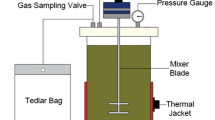Abstract
Optimization of an integrated anaerobic-aerobic bioreactor (IAAB) treatment system for the reduction of organic matter (Chemical Oxygen Demand (COD), Biochemical Oxygen Demand (BOD) and Total Suspended Solids (TSS) concentrations) in Palm Oil Mill Effluent (POME) to legal standards with high methane yield was performed for the first time under thermophilic condition (50°C–55°C) by using response surface methodology (RSM). The experiments were conducted based on a central composite rotatable design (CCRD) with three independent operating variables, organic loading rates in anaerobic compartment (OLRan) and mixed liquor volatile suspended solids (MLVSS) concentration in anaerobic (MLVSSan) and aerobic compartments (MLVSSa). The optimum conditions for the POME treatment were determined as OLRan of 15.6 g COD·L−1·d−1, MLVSSan of 43100 mg·L−1, and MLVSSa of 18600 mg·L−1, where high aerobic COD, BOD and TSS removal efficiencies of 96.3%, 97.9%, and 98.5% were achieved with treated BOD of 56 mg·L−1 and TSS of 28 mg·L−1 meeting the discharge standard. This optimization study successfully achieved a reduction of 42% in the BOD concentrations of the final treated effluent at a 48% higher OLRan as compared to the previous works. Besides, thermophilic IAAB system scores better feasibility and higher effectiveness as compared to the optimized mesophilic system. This is due to its higher ability to handle high OLR with higher overall treatment efficiencies (more than 99.6%), methane yield (0.31 L CH4·g−1 CODremoved) and purity of methane (67.5%). Hence, these advantages ascertain the applicability of thermophilic IAAB in the POME treatment or even in other high-strength wastewaters treatment.
Similar content being viewed by others
References
LaPara T M, Alleman J E. Thermophilic aerobic biological wastewater treatment. Water Research, 1999, 33(4): 895–908
Ahn J H, Forster C F. Kinetic analyses of the operation of mesophilic and thermophilic anaerobic filters treating a simulated starch wastewater. Process Biochemistry, 2000, 36(1–2): 19–23
Yeoh B G, Roslan M Y, Quah S K. Optimising methane yield in anaerobic POME treatment through temperature and process manipulations. Journal of Information Technology, 1991, 1: 19–31
Kim M, Ahn Y H, Speece R E. Comparative process stability and efficiency of anaerobic digestion; mesophilic vs. thermophilic. Water Research, 2002, 36(17): 4369–4385
Barr T A, Taylor J M, Duff S J B. Effect of HRT, SRT and temperature on the performance of activated sludge reactors treating bleached kraft mill effluent. Water Research, 1996, 30(4): 799–810
van Lier J B, Groeneveld N, Lettinga G. Development of thermophilic methanogenic sludge in compartmentalized upflow reactors. Biotechnology and Bioengineering, 1996, 50(2): 115–124
Chan Y J. A complete Palm Oil Mill Effluent (POME) treatment system using a novel integrated anaerobic-aerobic bioreactor (IAAB). Dissertation for the Doctoral Degree. Selangor, Malaysia: University of Nottingham, 2011
Beg Q K, Sahai V, Gupta R. Statistical media optimization and alkaline protease production from Bacillus mojavensis in a bioreactor. Process Biochemistry, 2003, 39(2): 203–209
Zinatizadeh A A L, Mohamed A R, Mashitah M D, Abdullah A Z, Isa M H. Optimization of pre-treated palm oil mill effluent digestion in an up-flow anaerobic sludge fixed film bioreactor: a comparative study. Biochemical Engineering Journal, 2007, 35(2): 226–237
Zinatizadeh A A L, Mohamed A R, Abdullah A Z, Mashitah M D, Hasnain Isa M, Najafpour G D. Process modeling and analysis of palm oil mill effluent treatment in an up-flow anaerobic sludge fixed film bioreactor using response surface methodology (RSM). Water Research, 2006, 40(17): 3193–3208
Bhatia S, Othman Z, Ahmad A L. Coagulation-flocculation process for POME treatment using Moringa oleifera seeds extract: optimization studies. Chemical Engineering Journal, 2007, 133(1–3): 205–212
Chan Y J, Chong M F, Law C L. An integrated anaerobic-aerobic bioreactor (IAAB) for the treatment of palm oil mill effluent (POME): start-up and steady state performance. Process Biochemistry, 2012, 47(3): 485–495
Chan Y J, Chong M F, Law C L. Effects of temperature on aerobic treatment of anaerobically digested palm oil mill effluent (POME). Industrial & Engineering Chemistry Research, 2010, 49(15): 7093–7101
Chan Y J, Chong M F, Law C L. Biological treatment of anaerobically digested palm oil mill effluent (POME) using a Lab-Scale Sequencing Batch Reactor (SBR). Journal of Environmental Management, 2010, 91(8): 1738–1746
Box G E P, Hunter J S. Multi-factor experimental design for exploring response surfaces. Annals of Mathematical Statistics, 1957, 28(1): 195–241
Jenkins D, Richard M G, Daigger G T. Manual on the Causes and Control of Activated Sludge Bulking, Foaming, and Other Solids Separation Problems. 3rd ed. London, UK: IWA Publishing, 2004
Kumar A, Yadav A K, Sreekrishnan T R, Satya S, Kaushik C P. Treatment of low strength industrial cluster wastewater by anaerobic hybrid reactor. Bioresource Technology, 2008, 99(8): 3123–3129
Shen C F, Guiot S R. Long-term impact of dissolved O2 on the activity of anaerobic granules. Biotechnology and Bioengineering, 1996, 49(6): 611–620
Bashir M J K, Aziz H A, Yusoff M S, Adlan M N. Application of response surface methodology (RSM) for optimization of ammoniacal nitrogen removal from semi-aerobic landfill leachate using ion exchange resin. Desalination, 2010, 254(1–3): 154–161
Mosey F E, Fernandes X A. Patterns of hydrogen in biogas from the anaerobic-digestion of milk-sugars. Water Science and Technology, 1989, 21: 187–196
Fannin K F. Start-up, operation, stability and control. In: Chynoweth D P, Isaacson R, eds. Anaerobic Digestion of Biomass. London: Elsevier, 1987
Author information
Authors and Affiliations
Corresponding author
Rights and permissions
About this article
Cite this article
Chan, Y., Chong, M. & Law, C. Optimization of thermophilic anaerobic-aerobic treatment system for Palm Oil Mill Effluent (POME). Front. Environ. Sci. Eng. 9, 334–351 (2015). https://doi.org/10.1007/s11783-014-0626-4
Received:
Accepted:
Published:
Issue Date:
DOI: https://doi.org/10.1007/s11783-014-0626-4




